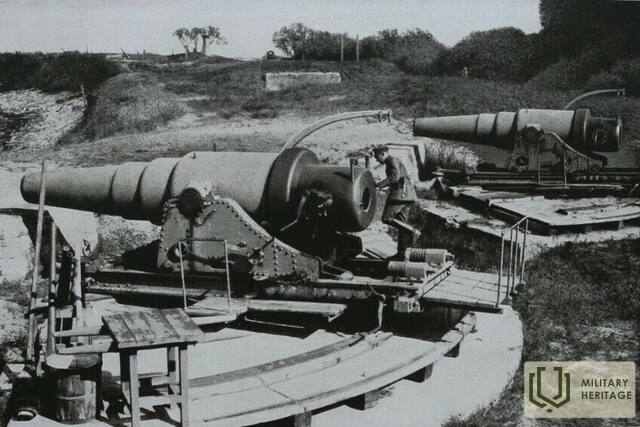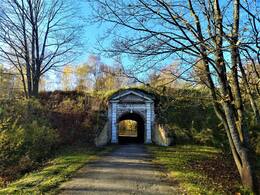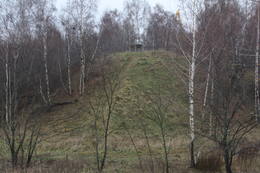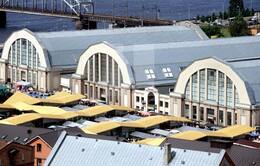About Daugavgrīva Fortress
The narrator describes an event in the Daugavgrīva Fortress during World War I, when it was bombed by a German army airship. The fortress was one of the strategic objects that retained its importance until the end of World War II.
“ (..) In the spring of 1916, on the night from the third day of Easter to the fourth, a German “Zeppelin” had been constantly flying over the besieged district of Riga and unexpectedly arrived above the fortress. The field guard at the bridge over the Hapak River had seen him at the very last moment. The elderly soldier of the Vologda detachment, having considered him to be the “bad guy” himself, had forgotten to notify the chief of the guard and raise the alarm in time out of fear and excitement, but had only come to his senses when the first bombs, presumably fired at the bridge, began to explode a hundred or a hundred and fifty steps away from the post in the material yards of the A. Baložs and P. Bērziņš wood factories, shattering and destroying some of the stables of the sons and blanks. There was a bright moonlight. A light fog covered the Daugava bays and the surrounding meadows. The clock showed already past midnight, when the first bomb explosions disturbed the fortress and the inhabitants of the area. A few minutes later, the fortress's searchlights began to work, the bomb explosions were joined by the noise of cannon shots and bursting shrapnel, the effect of which was further enhanced by the general silence of the night and the echo in the fortress ramparts. After ten or fifteen minutes, everything calmed down, only the batteries of the Ķemeri district could still be heard working, presumably escorting the departed «Zeppelin». The next morning, a closer look at the battle area and the damage caused showed that the latter were insignificant. In addition to the already mentioned dislodged and shattered plank and blank stables, the railway in the port dam had been destroyed for several axles, the port dam itself was also damaged and that was all, but two unexploded bombs from the «Zeppelin» had sunk into the ground when they fell and remained lying there. The bombs were needed, to be pulled out of the ground and destroyed, because if they were left to their fate, they could explode at any moment and cause great damage and disaster, especially the one that lay in Bolderāja. (..)”
The memoir was published in the newspaper “Latvian Rifleman”, No. 4. 1925. The title of the memoir is “This and That from the Life of Riflemen in Daugavgrīva”.
Related timeline
Related topics
Related objects
Daugavgrīva Fortress
Daugavgrīva Fortress (entry from Birzes street) is located on the Daugavgrīva Island where Buļļupe river joins the Daugava river. The fortress was built in the 17th century to defend from enemies moving in the direction of Riga, which was an important administrative, trade and production centre. Later it became the main fortification of the Latvian Army coastal defence with several support points. This defensive fortification system is one of the most valuable objects of Latvia's military heritage. This fortress has witnessed Latvian military history. For example, during the Crimean War (1853-1856) Latvian and Estonian gunboat crews were trained here. The main objective of these units was to protect local ports and the coast from attacks by the British navy. During World War I Daugavgrīva militiamen companies were formed here. These were the first Latvian combat units, which came even before the Latvian Riflemen. Nowadays it is possible to see the territory of the fortress. ‘Komētforts’ and the Seaside Nature Park are located nearby and Mangaļsala fortifications are on the other side of the Daugava river.
Zeppelin hangars of Riga Central market
Located in the center of Riga, opposite the Riga International Bus Station, near the Riga Railway Passenger Station.
Riga Central Market is the largest market in Latvia, once considered the best and most modern market in Europe. Its most striking symbol is the market pavilions built in the 1920s, which were originally used for military purposes.
During World War I, the German army established the Vainode airport in Kurzeme, where several airships were permanently stationed. They were oblong balloons filled with gas, with rooms attached to the hulls for transporting passengers and cargo. The control was provided by an internal combustion or electric engine and a wing in the hull. The airships were intended for reconnaissance or bombing the enemy, for example, they carried out an attack on the Russian army seaplane airfield near Roņu Island. It is known that the hangars were called “Walhalla” and “Walther”.
After the Latvian War of Independence, the hangars were dismantled and used for the construction of the Riga Central Market hangars, with the intention of leaving them in their original dimensions. Later, it was decided to use only the upper parts of the hangars.
Today, you can see the metal structures of the German army airship hangar. The market allows you to get acquainted with the evidence of the beginnings of world aviation in a pleasant way. Tour booking: +37167358157; gints.aksiks@rct.lv.








